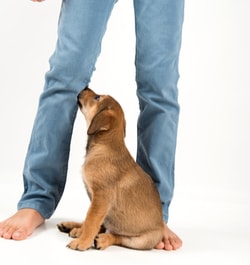Health Issues May Be the Cause
Your dog assuming the lazy dog sitting position or the sloppy sit might point towards an underlying medical condition. At the very least, you should take measures to prevent these from happening.
Routinely sitting in a sloppy posture is probably a sign that something is wrong and causing your dog discomfort but what steps should you take in such a case and will it resolve without action? More on that at the end of this article.
It’s so funny seeing your dog sit like a human, maybe even watching TV in the evening but this behavior is pretty similar to the puppy sit in regards to the causes.
Your dog chilling in this position once in a while is probably a result of him imitating you. Dog breeds with long legs like the Great Dane tend to relax in this “sit” more often compared to smaller legged breeds.
Some dogs also adapt to this posture because they like your reaction to it when you burst out in laughter. Keep in mind that any sitting position should be closely monitored and you should look for cues of discomfort.

Photo by Marcus Cramer on Unsplash
Now that I have talked about the weird ways of dog sitting, I should also mention the straight sit.
This is the only position that should be taught to puppies from the beginning and should always be encouraged to prevent back pain.
The dog’s spine should be upright with both knees to the sides and his feet tucked nicely underneath.
Just like humans, dogs should take care of their posture and an effortless straight sit is a sign of a healthy spine.
Where Dog’s Sit Says A Lot as Well

20) Back to back It’s so cute when you see two dogs sleeping back to back! It’s even sweeter when they sleep back to back with their owners! A dog will only do this with one of his “pack” members that he 100% trusts.

Dogs’ Body Language Explained
Your dog’s sitting position can reveal a lot about his health, happiness, and mood. If you study your dog’s body language through his readable habits, you will be able to decipher the meaning of his sitting position.
Just like humans have body language that can be read by others, dogs have body language that displays their thoughts and feelings at a given time.
The most obvious is how a frightened dog cowers in fear or an aggressive dog charges confidently. These are all physical indications of inward emotion.
Your dog’s sitting position can tell you a lot but where he sits can tell you even more. Your dog may sit on your lap, or he may sit with his legs outstretched on the floor. These sitting positions reveal your dog’s mental state at the time.
The dog sit seems to be common across all the dog breeds. It also seems to be a command canines are naturally inclined to.
If you would like to gain a deeper perspective into your dog’s thoughts and feelings based on their sitting position then this is the article for you. It will help you to evaluate the sleeping and sitting position of your dog.